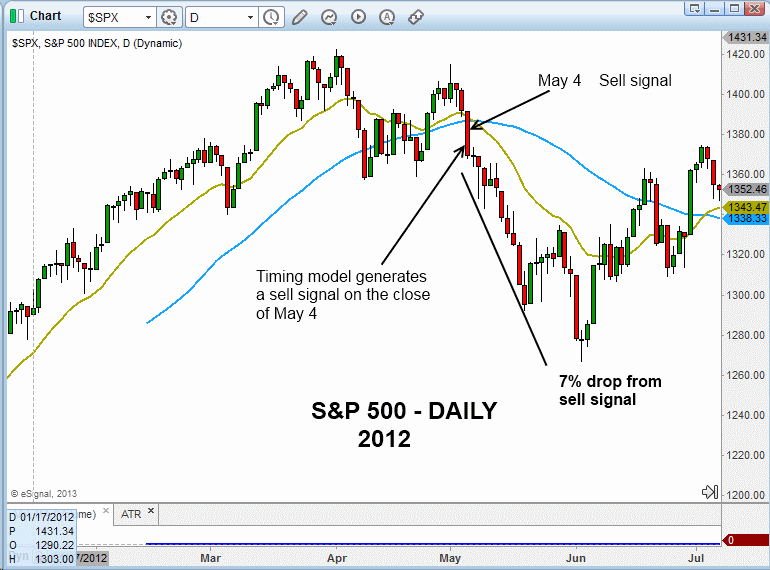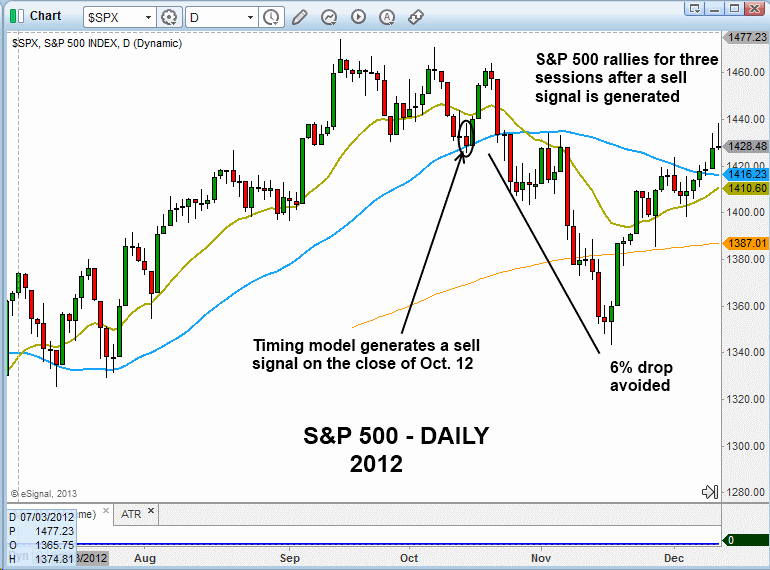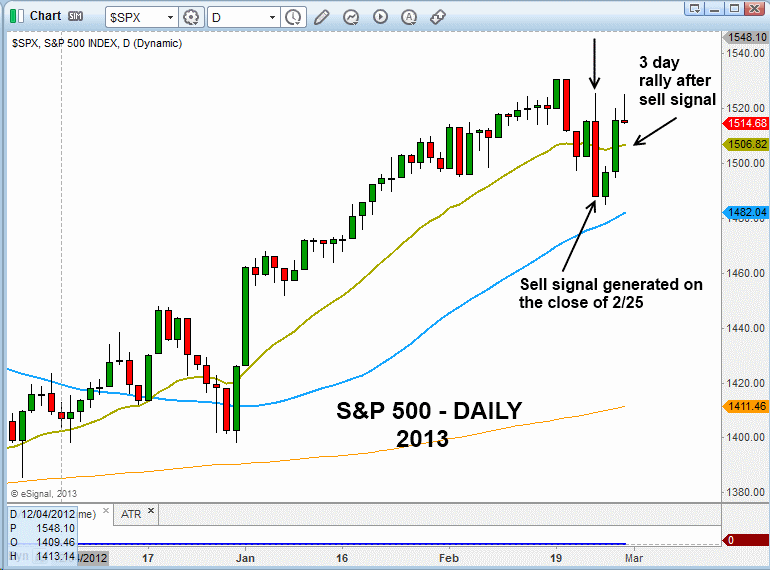Since February 25, we have been operating on a “sell” signal that was generated by our rule-based market timing system (learn exactly what that means). We have been using that same market timing strategy internally since 2006, and it has always done a pretty good job of keeping us in line with the intermediate-term trend of the broad market, which is where we operate with our short to intermediate-term swing trading system.
Although stocks have actually moved slightly higher since our most recent sell signal was triggered, it’s important to understand the market does not always need to immediately break down in order for the timing model to have value.
Sometimes a sell signal is generated and the market immediately rolls over, but other stock market timing sell signals lead to an initial short-term bounce before the market moves substantially lower.
Obviously, we can never know in advance what will happen immediately following a new sell signal. Still, we always respect a bearish market timing signal by moving to cash and/or tightening up stops on long positions and waiting for conditions to improve before establishing new long positions. A new sell signal also allows us to selectively short sell stocks and ETFs with relative weakness.
To clearly illustrate the different ways a market can behave after receiving a sell signal from our market timing model, the charts below detail the subsequent price action of two different intermediate-term sell signals that were generated by our market timing strategy in 2012:

After a decent rally in early 2012, the distribution days began piling up in late April and early May, forcing us out of several long positions by May 3 and generating a 100% sell signal on the close of May 4 (as annotated on the chart above). In this case, the timing of the signal was perfect, as the market plunged 7% over the next 10 sessions.
Following a very short-lived rally in August/September of 2012, the number of distribution days once again began increasing within a short period of time, and leading individual stocks began falling apart as well. These are two of the main components (along with a few proprietary tweaks) that determine when our market timing model issues a new sell signal.
Given the bearish action described above, our market timing strategy generated a sell signal on the close of October 12, 2012. But although this prompted us to quickly exit our long positions, this time the stock market did not immediately come unglued.
Instead, there was a short-lived bounce that inevitably attracted some “late to the party” Charlies who were not paying attention to the bearish volume patterns in the market. Nevertheless, after one day of stalling on October 18, the market sold off sharply, erasing all of its gains from August and September:

Finally, let’s look at our most recent sell signal that was issued on February 25, 2013 (just four days ago). Much like the price action that followed the most recent sell signal from October of 2012, stocks did not sell off right away. Rather, the broad market bounced higher for a few days:

Because we are not mystical prophets, we don’t know if the market will sell off sharply over the next few weeks. Nevertheless, we have not been willing to establish new long positions over the past few days (though we entered a few new short positions) because experience has shown us exactly what can happen when the volume patterns in the market suddenly turn bearish.
Although the market pushed higher on February 26 and 27, it did so on lighter volume. This followed three out of four big declines on higher volume. Yesterday (February 28), the market stalled, which reinforced the sell signal generated by our stock market timing model on February 25.
Quite a few supposed “gurus” claim that market timing doesn’t work, but those who believe this are clearly not following the right indicators. Broad market volume patterns, combined with poor performance by leading individual stocks, always play a crucial role in identifying significant market tops and bottoms.
Many investors make the mistake of focusing purely on price patterns or percentage gains of a broad-based index, while paying little or no attention to the market’s volume patterns. To learn more about why volume is such an important indicator, check out 5 Technical Reasons Stocks May Soon Move Lower, an article we wrote on October 8, 2012 (just four days before our October 12 “sell” signal highlighted above).
When volatility increases, trading can become quite emotional, which can easily lead to bad decisions and a ton of regret. The best way to remove (or at least minimize) emotions from trading is to follow a well-defined and disciplined trading strategy at all times.
Our proven system for market timing allows us to operate with confidence during stressful periods in the market. Are we wrong sometimes? Of course! But successful trading isn’t about being right or wrong (ego); rather, it’s about doing the right thing. When traders consistently do the right thing in trading, the money eventually follows.
Are you are frustrated by recent stock market volatility, but still concerned you might miss critical turning points in the market? Lower your stress by signing up for your 30-day risk-free trial subscription to The Wagner Daily, our swing trading newsletter that always includes access to our market timing strategy that works.

One comment on “How To Navigate Volatile Stock Markets Through Market Timing”